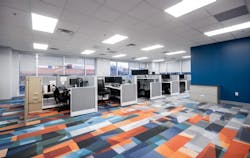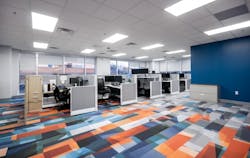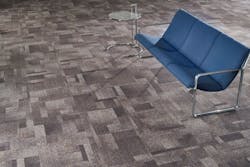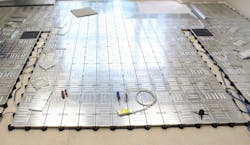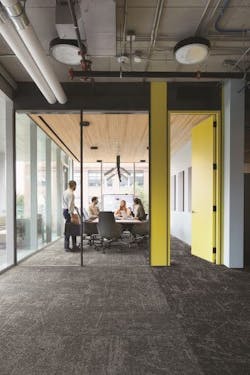Take the Guesswork Out of Carpet Specifications
A client once told me that choosing carpet was much like choosing a diamond. Unless you had the right expertise and knew what to look for, you are left at the mercy of the sales representative as they explain the importance of the cut, clarity, color and carat weight. A diamond is just a rock without the story of the specification. The mysteries surrounding a diamond can confuse many people and, in the same way, so does commercial carpet.
Commercial carpet is just a rug without the story of the specification. There have been many advances in commercial carpet construction over the years. Let’s take some of the mystery out of specifying what is now high-performance, soft-surface commercial flooring.
First, it’s important to understand the basic components of commercial carpets and how or why they are used.
*This article is sponsored by Interface Inc.
Carpet Construction 101
Before you can make informed specification decisions for carpet, it’s important to understand its DNA and what makes different types of carpet suitable for different applications. A few basic components make up commercial carpet products and their characteristics, including:
Yarn Systems: Yarn systems are important in a commercial environment and can impact the longevity of the installation. There are four main yarn systems available for commercial carpet.
1. PET/Polyester: Highly stain resistant; low appearance retention in normal construction.
2. Olefin/Polypropylene: High resistance to chemical and sunlight fading; subject to burn marks due to its low melting point.
3. Nylon: Most used; excellent appearance retention and stain resistance.
4. Wool: Durable and self-extinguishing.
Due to superior appearance retention and performance characteristics, nylon is the predominant fiber used in commercial environments. Nylon is the one fiber that chemically can be produced using different carbon polymers leading to different yarn types referred to as type 6 or type 6,6. The most common nylon is type 6 for its excellent performance at a lower cost and ease of closed loop recyclability. Type 6,6 is up to 20% harder, giving it improved long-term performance, but is more expensive and difficult to recycle at the end of life. If reclaimed at the end of life, many commercial carpets are recycled into things such as car parts or other plastics.
Construction: Carpets have three basic construction types: cut pile, loop pile, and cut and loop. Low and dense loop pile construction will perform best for high-traffic areas. Cut and loop and cut pile constructions can provide a more elegant feel and are typically used in medium- to light-traffic areas. Good carpet construction in tufted carpet represents the balance between multiple construction elements such as gauge, stitches per inch, ounce weight and pile height.
The Carpet and Rug institute (CRI) developed a model that classifies carpet using a Texture Appearance Retention Rating (TARR). This model is based on simulated wear tests and provides a rating for different levels of traffic. The CRI recommends the following scale for TARR:
- Moderate ≥ 2.5 TARR
- Heavy ≥ 3.0 TARR
- Severe ≥ 3.5 TARR
Dye Methods: There are two option when dyeing carpet: pre-dyeing or post-dyeing. In pre-dyeing the color is added to the fiber before it is made into carpet. In post-dyeing, the carpet or fiber is made using white yarn and color is added after.
- Solution dyed: Color pigment is added to the fiber while it is in molten state making it extremely colorfast. It has the benefit of large dye lots, but standard colors are limited.
- Yarn dyed: This is a process of dyeing the yarn individually. Typically used for space dyed or skein dyed.
- Piece dyed/Beck dyed: Carpet is manufactured using white yarn and then is submerged into a dye bath to apply color. Virtually unlimited colors available. Limitations are smaller dye lots.
- Printing/Dye injection: This process applies color to the carpet by screen print or inkjet. The advantages are precise color placement and nearly unlimited pattern options.
Color/Pattern: Color and pattern play a significant role in the long-term appearance of the product because your clients are concerned with the appearance and feel of their space. In addition to the emotion that color can generate when new, it will give a different emotion when the soiling shows. We all know that a lighter color will show more soiling and stains than a darker color. This holds true in every textile product.
As such, choosing a pattern that will blend with the type of soil or stains in the environment will lessen their visibility. In addition, organic and geometric patterns will provide enough visual distraction to hide the stains as opposed to monochromatic products.
[Related: Breaking Down the Difference in Resilient Flooring]
Broadloom or Modular Tile: In commercial environments, broadloom refers to rolled goods typically that are 6-feet, 12-feet and even up to 15-feet wide. Modular tile refers to units that may come in a variety of sizes and shapes, creating a design element on the floor defined by the shape of the tile. Both constructions have their benefits for specific applications.
For instance, the most functional examples of broadloom use would be waterfall installation on lobby stairs. In contrast, modular carpet tile is a very practical option for access flooring or under modular furniture. There are no hard and fast rules for the use of broadloom or carpet tiles, but some applications highlight the best results for each format.
If your space features any of the following elements, your first choice should be carpet tiles:
- Access flooring: Easily remove carpet tiles to access wiring below.
- Workstation furniture: No need to dismantle furniture; just lift and install carpet tiles.
- Projects on the second floor or above without a freight elevator: It is difficult to get 12-foot broadloom into small elevators.
- Curved spaces or designs: Carpet tiles minimize waste created by non-traditional layouts.
Now that you understand the basics of construction you can use that to specify the right materials for the space.
Questions to Ask the Client
Knowing which type of carpet will be best suited for a project will depend on the application it’s being used for. Some helpful questions to narrow down the type of carpet that’s best suited for the client’s needs include:
- Is this a remodel or a new construction?
- What type of soil is likely to be tracked on the carpet?
- What types of spills may occur?
- Life expectancy of the installation?
- What amount of traffic is in the space? (light, moderate, heavy)
- Will there be rolling traffic?
The answers to these questions will help determine which type of carpet, construction, yarn and dyeing process to choose for the best result.
Sanitizing
In our post-pandemic world, many of the concerns will revolve around sterilization and limiting the risk of infection transmission. Many clients will immediately think that hard surfaces would be the answer over carpet.
The truth is that there are proper methods to clean and sanitize both hard surface and carpet. A professional floor care contractor can sanitize both properly. One advantage that carpet has over hard surface is in the reduced transmission of germs. Carpet, being a soft surface, will hold the germs closer to the floor, usually less than 36 inches, minimizing the transmission of germs to door handles or faces and making sanitizing more efficient.
Listen to Bruce Sampos and Robert Nieminen discuss this topic in this How to Specify I Hear Design podcast, sponsored by Interface, Inc.
Working with a Manufacturer
When working with a manufacturer, be clear on project timing, size and budget limitations. The price of nylon fluctuates with the commodities markets and pricing can vary month to month. To maximize efficiency, most carpets are manufactured to order. In the budgeting process, it is important for a carpet manufacturer to understand the size and scope of a project before they can accurately provide a production lead time for shipment.
Custom color/pattern: Every manufacturer has the capability to make custom colors or patterns. A typical solution dyed carpet will have two or more yarn colors in a standard pattern. Besides changing the graphic pattern, changing the color of one or more of those yarns is one of the easiest ways to modify the visual.
For a minimum of 1,000 square yards or more, simply choose another color from the yarn bank options to create a new look. The tufting pattern remains the same, but the look of the product can change completely. With piece dyed products, especially print or dye injected products, the minimums are much lower, and the versatility of the pattern is only limited to your imagination.
Environmental Considerations
The carpet industry takes a holistic approach to sustainability that is responsible, proactive, and seeks to balance various stakeholder needs and interests. Carpet manufacturers focus on reducing water and energy use, strive to create zero waste, incorporate recycled content in new carpet products and recycle carpet to reduce the amount of discarded carpet that goes into landfills, according to CRI.
In fact, over the past 15 years, carpet manufacturers have invested in creating a carpet recycling industry that has diverted over 5 billion pounds of carpet from landfills.
One way to ensure your carpet specifications meet the sustainability goals of your project is to look for disclosure tools that can help determine which product is the best match, including:
- Environmental Product Declaration (EPD) is an international standard report that documents the environmental impacts of a product throughout its lifecycle.
- Health Product Declaration (HPD) is a report of the ingredients in a building product and the associated impact on health.
- LEED is the most widely used green building rating system in the world. Products that satisfied prerequisites can contribute to achieving different levels of certification.
- NSF/ANSI 140 Sustainability Assessment is a set of lifecycle assessment principles written by manufacturers, regulatory agencies, customers, end users and academics.
The global COVID-19 pandemic gave the planet time to rest from human activity. Now, design practitioners can choose regenerative solutions to help heal it.
Case in point: In early April this year, global CO2 emissions fell by an estimated 17 million metric tons per day, or 17%, according to The New York Times. In other words, the earth experienced a period of much-needed rest from human activity during the global shutdown. However, by mid-June, as countries eased their lockdowns, emissions had ticked up to just 5% below the 2019 average.
While the reduction in greenhouse gases was only temporary, it points to an irrefutable truth: reversing our impact on climate change is achievable—and it’s possible to make those big shifts in a short amount of time. This is a core belief at Interface, and one that we are working toward daily.
Using the lessons we’re learning now, how can we navigate the need to live and thrive in a world in balance with its ability to recover? One way is to make sure we design solutions—whether it’s cities, buildings or interiors—with a regenerative lens. We’re trying to do that at Interface, making sure our factories and products push the boundary to be regenerative.
We’ve taken aggressive measures to not only achieve our goal of becoming carbon neutral as a company, but we have also innovated on ways to work with recycled content and bio-based materials—efforts which have led us to develop carbon negative carpet tiles.
At the same time, we are also encouraging others to act because scientific research has already demonstrated how to reach safe climate limits sooner: radical decarbonization. In other words, we need to remove carbon from our atmosphere and protect natural carbon sinks.
Fortunately, there is significant opportunity to reduce the level of embodied carbon in the built environment through responsible material selection and specification. That means designers and architects can now choose products that go beyond carbon neutrality to make a more significant impact on reversing climate change.
In order for the earth to heal, we must do more than reduce our carbon footprint; we need to help regenerate it. And that’s exactly what designers can do by specifying our products.
As Janine Benyus, author and co-founder of the Biomimicry Institute, puts it: “Whatever part of the earth you touch, you can heal.”
Interfaceinc.com/ClimateTakeBack
Installation and Project Logistics
Choosing the right product for the project is truly rewarding. However, the satisfaction can quickly become disappointment if not installed by a professional flooring contractor. True manufacturing claims about a product’s performance across the carpet industry typically happen less than 3% of the time. Most claims often result from subfloor conditions, unaddressed moisture in the slab or from substandard labor.
Having a true professional flooring contractor evaluate the site conditions prior to budgeting will alleviate any surprises down the road. Not all flooring contractors are created equal and the low bid is not always the best deal. There are many industry resources that can help you identify a professional flooring contractor with a solid reputation for excellence and who is financially sound enough to handle any size project.
As you can see, specifying carpet is anything but simplistic. However, with a little bit of knowledge and research, you can feel confident about ensuring the carpet you select is going to look and perform its best.
About the author:
Starting as a sales representative, he moved up to Regional VP and Divisional VP, and eventually Executive VP. Bruce transitioned to Mohawk as a Regional VP, and then joined Starnet in December of 2018 as VP of Business Development.
Experience other How to Specify topics:
